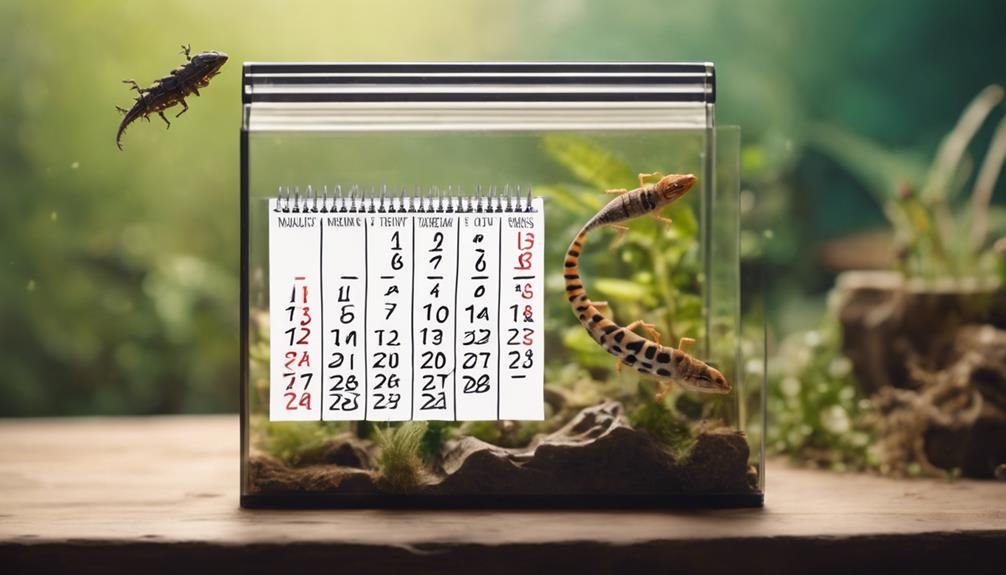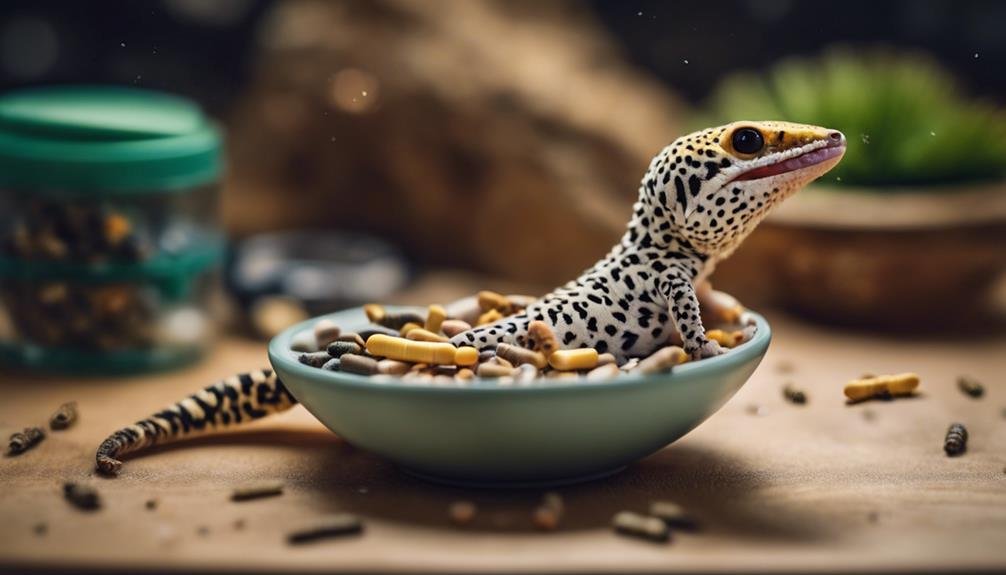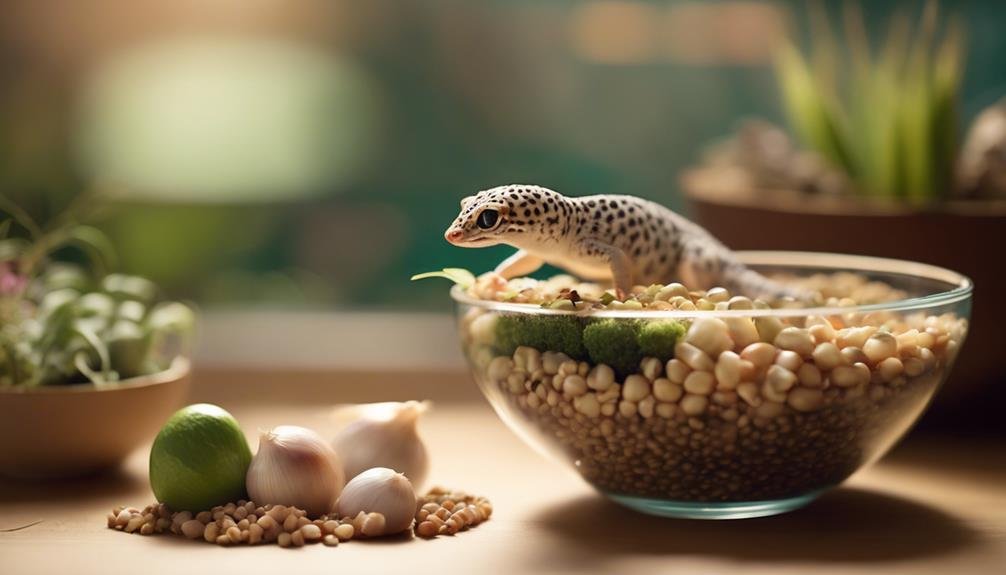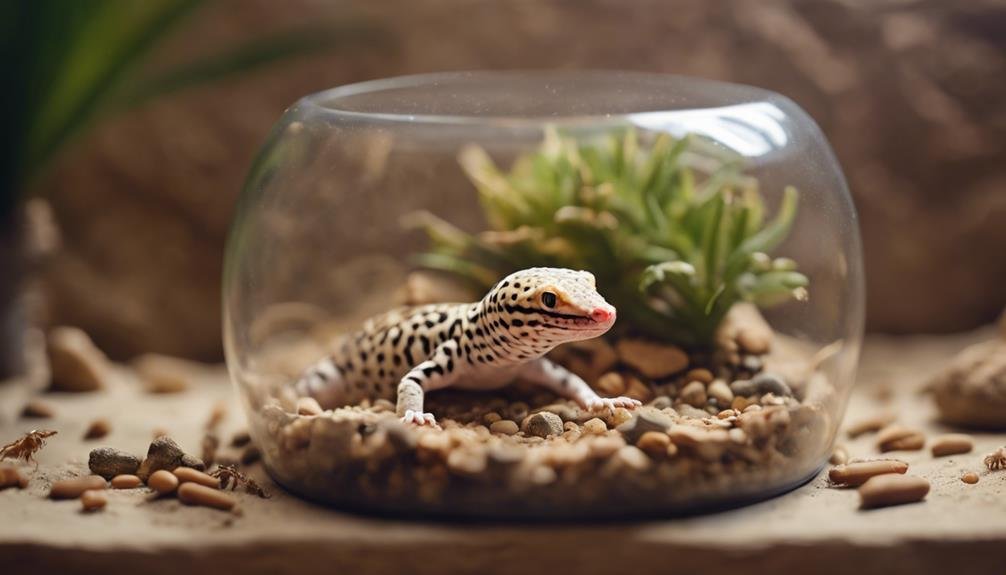When you’re considering what to feed your leopard gecko, it’s important to understand that they thrive on a diet of live insects. You’ll often find yourself providing meals of crickets, mealworms, and occasionally dubia roaches, all of which should be gut-loaded to enhance their nutritional value. However, the variety and frequency of these feedings aren’t as straightforward as you might think. There are specific needs at different stages of your gecko’s life that can greatly impact their health and vitality. Have you considered how these feeding practices affect their overall wellbeing and lifespan? Let’s explore what these little predators require to stay healthy and how you can meet these needs effectively.
Key Takeaways
- Leopard geckos primarily consume live insects such as crickets, mealworms, and dubia roaches.
- Insects should be appropriately sized, not larger than the space between the gecko’s eyes.
- It’s beneficial to gut-load insects with nutritious foods before feeding them to geckos.
- Dust live insects with calcium powder to ensure proper bone health.
- Treats like waxworms and superworms should be given sparingly due to their high fat content.
Essential Diet Overview
Understanding what to feed your leopard gecko is crucial for its health and longevity. Leopard geckos thrive on a diet of live insects, which provide the necessary protein they need to stay healthy. As an owner, you should focus on selecting the right insects for your leopard gecko, taking into account their life stage. For instance, an adult gecko requires larger prey compared to juveniles.
Insects for your leopard should be appropriately sized to prevent choking hazards. A good rule of thumb is to offer prey that’s no larger than the space between your gecko’s eyes. This guideline helps ensure that your leopard gecko can safely ingest and digest its food without complications.
It’s also important to monitor how much and how often your gecko eats. Adult geckos typically do well with being fed every other day, but this can vary based on their individual health and activity level. Paying close attention to their eating habits helps you adjust their diet as needed, ensuring they remain in good health throughout their life. By managing these aspects of their diet, you’re setting up your leopard gecko for a long and healthy life.
Recommended Insect Varieties
To keep your leopard gecko healthy, include a variety of live insects such as crickets, mealworms, dubia roaches, and silkworms in its diet. Feeding your gecko a mix of these insects helps guarantee they receive a broad spectrum of nutrients, mimicking their natural diet in the wild. Crickets and mealworms can be staples, while dubia roaches and silkworms are excellent for adding diversity.
It’s essential to avoid wild-caught insects, which might carry diseases that could harm your gecko. Instead, opt for insects that have been bred in secure environments to prevent any health risks. These controlled conditions also allow you to practice gut-loading, which is crucial for your gecko’s nutrition. Gut-loading involves feeding the insects high-quality foods that pass on their nutritional value to your gecko when consumed.
Feeding Schedule Guidelines


Now that you know what insects to feed your leopard gecko, let’s look at how often these meals should be scheduled. For juvenile geckos, you should aim to feed them every other day. This important feeding schedule supports their rapid growth and development needs. As your gecko matures into an adult, you can reduce the feeding frequency to 2-3 times per week. This adjustment in the feeding schedule helps prevent overfeeding and maintains their health as their metabolism slows.
It’s essential to dust the live insects with calcium powder before offering them to your gecko. This guarantees they’re getting essential nutrients necessary for bone health. Always have fresh water available, and keep a dish of calcium powder in the enclosure so your gecko can supplement as needed.
Be mindful to monitor your gecko’s weight regularly. If you notice any significant weight change, adjust the feeding amounts accordingly. Overfeeding can lead to health issues, whereas underfeeding can cause nutritional deficiencies. Sticking to these guidelines will help keep your leopard gecko healthy and thriving.
Importance of Gut Loading
Gut loading your leopard gecko’s prey is essential to guarantee they receive the best possible nutrition. This process involves feeding the insects a nutrient-rich diet before they’re offered to your gecko, greatly enhancing the nutritional value of the insects. By doing so, you’re not just feeding your gecko; you’re making sure they get a powerhouse of essential nutrients necessary for their health.
When you gut load insects, you enhance their nutritional profile, which is directly passed on to your leopard geckos. It’s like giving your pet a fortified meal each time they eat an insect. Here’s a quick guide on what to feed these insects to maximize the benefits:
| Food for Insects | Benefits for Leopard Geckos |
|---|---|
| Fruits and Vegetables | Provides vitamins and hydration |
| Commercial Gutload Diets (e.g., Repashy SuperLoad) | Ensures balanced intake of essential nutrients |
| Grains and Cereals | Adds necessary fiber |
| Leafy Greens | Rich in minerals and vitamins |
Nutritional Supplements Needed


You’ll also need to sprinkle nutritional supplements on your leopard gecko’s food to guarantee they get a balanced diet. Calcium powder is important for maintaining a proper calcium-phosphorus ratio in their diet, especially since they’re primarily insect feeders. This essential mineral is critical in preventing metabolic bone disease, a common issue in captive lizards.
For an adult leopard gecko, the use of all-in-one powders can simplify the supplementation process. These powders combine essential nutrients and vitamins, making sure your gecko doesn’t miss out on anything important for their health. However, the frequency and type of supplement may vary depending on whether your gecko has UVB lighting in their enclosure. Geckos exposed to UVB lighting synthesize vitamin D naturally, reducing their dietary need for D3 supplements. In contrast, those without access to UVB lighting need frequent dietary D3 to aid in proper calcium metabolism.
Remember to provide fresh water daily, as hydration plays a key role in nutrient absorption. Occasional multivitamin powders can offer additional nutrients, rounding out their diet and supporting overall well-being. By tailoring these supplements to your gecko’s specific needs, you’ll help ensure they lead a healthy, balanced life.
Treats and Occasional Foods
While leopard geckos primarily thrive on a diet of insects, you can occasionally offer treats like waxworms and superworms to enrich their feeding routine. However, you should give these treats sparingly due to their high fat content. These special snacks can add variety and enjoyment to your pet’s diet but aren’t necessary for their health. It’s important to make sure that these treats are just a small part of the diet for your pet.
Live food is essential for leopard geckos, as it stimulates their natural hunting instincts. Always opt for live, wild caught insects when possible, as these are closest to what geckos would eat in their natural habitat. This not only keeps your gecko engaged but also provides the most nutrition.
Remember, the size of the insects is also significant. Make sure the insects aren’t too large for your gecko, especially for younger or smaller individuals, to prevent choking hazards. Always monitor how your gecko eats these treats to catch any eating difficulties or abnormalities early.
Lastly, always provide fresh water alongside their meals. Hydration plays an important role in your gecko’s overall health and aids in digestion of these richer, fattier treats.
Foods to Avoid


Although fresh, live prey is essential for your leopard gecko’s diet, there are specific foods you should avoid to keep them healthy and safe. Toxic insects, for example, can pose a serious risk. It’s important you steer clear of these to prevent harming your pet. Moreover, avoid feeding wild-caught insects, as they may carry diseases or have been exposed to pesticides, which could be detrimental to your gecko’s health.
Dried or processed foods are also a no-go. These options lack the essential nutrients your gecko needs to thrive. Instead, focus on providing a varied diet consisting of safe, live insects to make sure they receive all the necessary vitamins and minerals.
Here’s a quick guide to help you remember what to avoid:
| Food Type | Reason to Avoid | Alternative Offered |
|---|---|---|
| Toxic insects | Can be fatal | Calci-worms, crickets |
| Wild-caught insects | Risk of disease and pesticides | Cultured live insects |
| Dried/processed foods | Lack nutritional value | Fresh, live insects |
Signs of Dietary Issues
If your leopard gecko shows signs like refusing to eat or experiencing weight loss, it may indicate dietary issues. These symptoms, along with lethargy and abnormal stool, are red flags that shouldn’t be ignored. When your gecko turns down meals consistently, it’s crucial to assess what might be going wrong in its diet.
Weight loss can occur if your gecko’s diet is lacking essential nutrients. If you’ve been overfeeding fatty insects, this might lead to obesity initially but could swing to weight loss due to digestive troubles. Similarly, lethargy often results from inadequate calcium and vitamin supplementation, pointing towards metabolic bone disease—a serious health concern that requires immediate attention.
Abnormal stool, which could be unusually soft, hard, or oddly colored, often indicates gastrointestinal distress. This could stem from offering inappropriate or even toxic foods. Monitoring your gecko’s eating habits and stool quality helps in early detection of these issues.
To prevent such dietary mishaps, always ensure a balanced diet and consult a vet if you notice any troubling signs. Regular check-ups can help you tweak the diet as needed and keep your leopard gecko healthy and active.
Hydration for Leopard Geckos


Keep your leopard gecko hydrated by providing fresh drinking water daily. It’s important for their health and vitality. A shallow dish works best, making sure they can access the water easily without any risk of drowning. Also, consider placing a large rock in the water dish, which helps any crickets escape if they fall in, preventing contamination.
Monitor your gecko’s water intake closely. If you notice signs of thirst or dehydration, adjust the placement of the water dish, perhaps moving it closer to where your gecko likes to spend most of its time. Remember, dehydration can be a serious issue, so keeping an eye on these signs is key for their wellbeing.
Here’s how you can maintain proper hydration for your gecko:
| Action | Purpose | Frequency |
|---|---|---|
| Provide fresh water | Maintain proper hydration | Daily |
| Use shallow dish | Easy access and safety | Check dish daily |
| Place rock in dish | Prevent insect drowning | As needed |
| Monitor intake | Notice signs of dehydration | Continuously |
| Clean dish | Maintain hygienic drinking space | Regularly or as needed |
Always clean the water dish regularly to keep it free from any debris or buildup, ensuring a hygienic environment for your gecko to drink from.
Can Leopard Geckos Eat Similar Foods to Snapping Turtles?
Leopard geckos and snapping turtles have different dietary needs. While leopard geckos primarily eat insects, snapping turtles diet information suggests they consume a variety of foods including fish, insects, and even some plant matter. It’s important to provide the right diet for each reptile to ensure their health and well-being.
Monitoring Food Intake
To guarantee your leopard gecko stays healthy, closely monitor their food intake by tracking how much they eat at each feeding. Knowing what geckos eat—mainly live insects like crickets and mealworms—is just the start. It’s important to adjust the feeding frequency depending on your gecko’s age, size, and how active they are.
Here are three key aspects to focus on when monitoring their eating habits:
- Track Uneaten Insects: Always remove uneaten insects after each feeding session. This not only keeps the habitat clean but also helps you understand how much your gecko is actually consuming, preventing overfeeding and potential health issues.
- Observe Body Condition and Weight: Regularly check your gecko’s body condition and weight. A healthy gecko shouldn’t be too skinny or overweight. Changes in body condition can indicate whether they’re getting the right amount of food.
- Adjust Feeding Frequency and Amount: Younger geckos typically require more frequent feedings, while adults may eat less often. Watch how your gecko eats and adjust the amount and frequency of feedings accordingly to ensure they’re receiving adequate nutrition without excess.
Conclusion
As a leopard gecko owner, you’ll want to provide a diet of live insects like crickets and mealworms, ensuring they’re small enough to prevent choking. Remember to gut-load and dust these insects with calcium to meet nutritional needs.
Stick to a regular feeding schedule and watch for signs of dietary problems. Also, keep your gecko hydrated and monitor their food intake closely.
Avoid fatty foods like waxworms except as occasional treats to keep your gecko healthy and happy.


